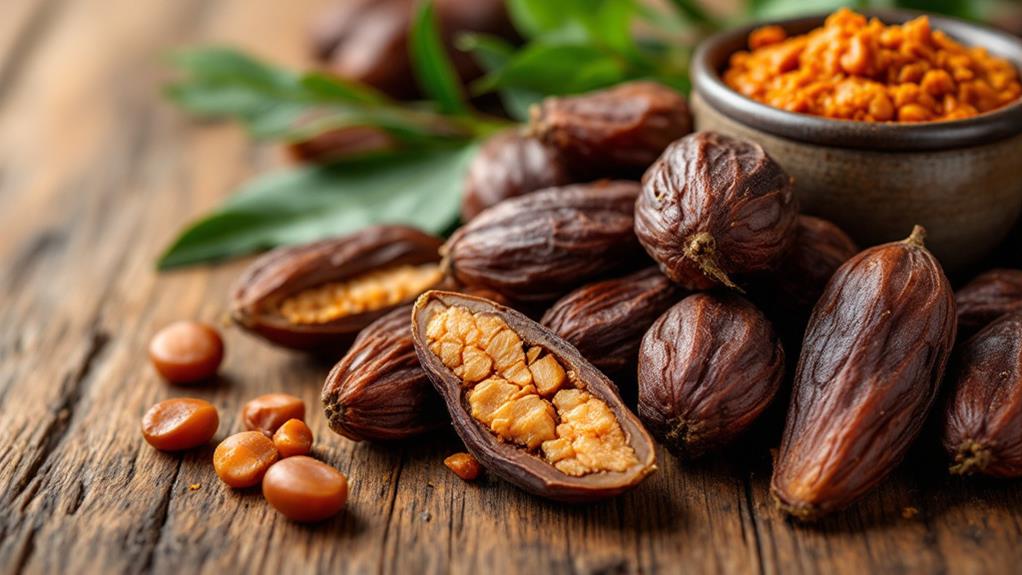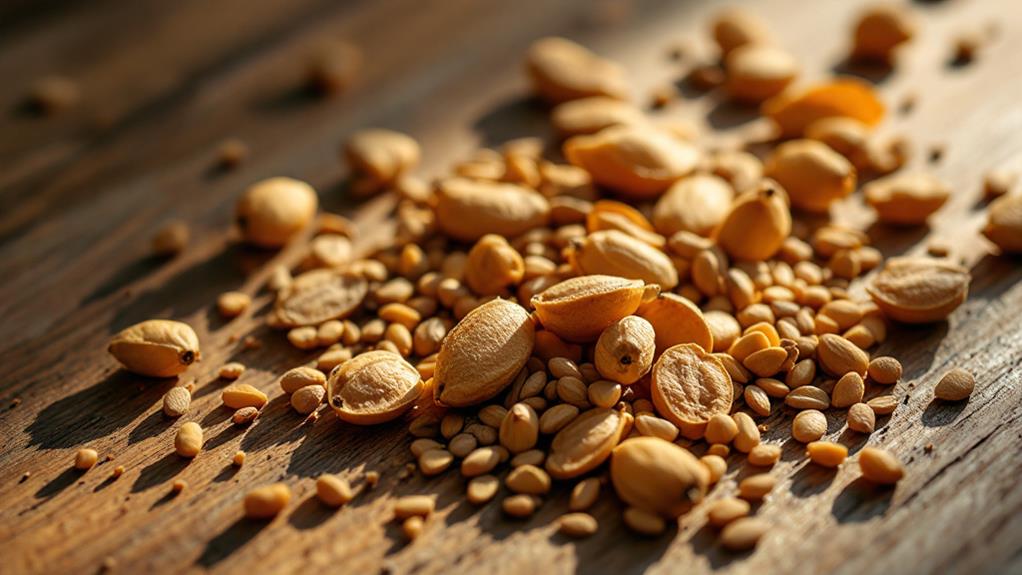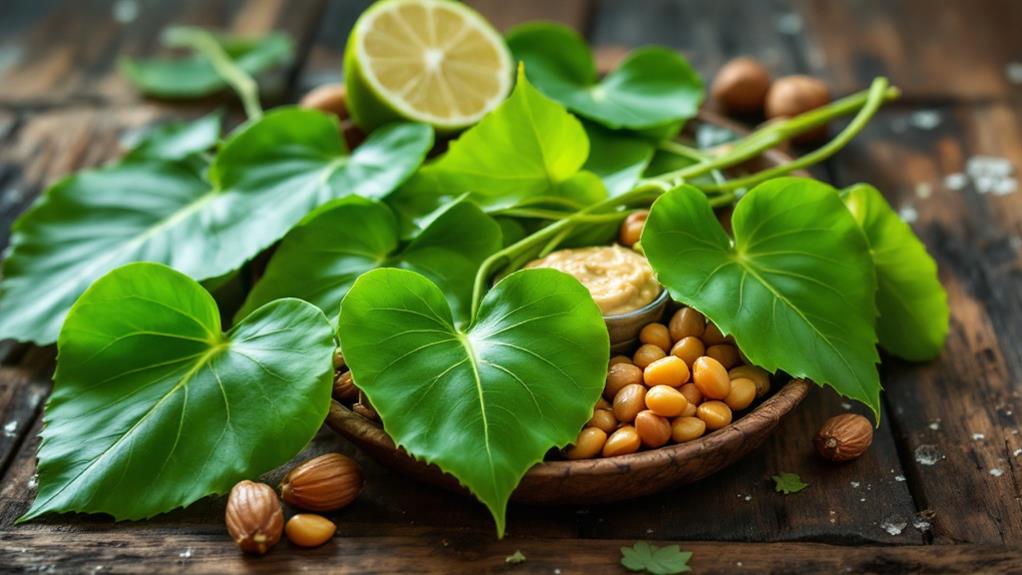What Are Tamarinds and Are They Worth Adding to Your Diet?

Tamarinds are tropical fruits known for their unique sweet-sour taste, offering a flavorful twist to your diet. They're rich in crucial vitamins like A, C, and E, in addition to dietary fiber, helping elevate your immune system and digestive health. You can enjoy tamarind in varied forms, such as raw pods, paste, or concentrate, enhancing both savory dishes like curries and sweet treats. While generally safe, moderate consumption is advisable due to their natural sugar content. If you're curious about their culinary versatility and potential health benefits, you're in for an exciting expedition.
Understanding Tamarind Origins
When exploring the origins of tamarind, it's essential to recognize its roots in Africa, where it initially flourished as a tropical tree. Known scientifically as Tamarindus indica, this remarkable tree thrives in hot, dry climates, growing up to 80 feet tall. You can find tamarind trees widely cultivated in regions like India and Pakistan, thanks to their adaptability to tropical and subtropical environments.
The tamarind fruit is a pod-like legume, housing a distinctive sweet-sour pulp. This edible pulp is not only a staple in numerous culinary applications worldwide but also holds a significant place in traditional medicine. In India, tamarind is affectionately called the "date of India," underscoring its integral role in both cuisine and health practices. The tree produces its fruit in pods, which are ready for harvest 6 to 8 months after flowering.
Understanding tamarind's origins helps you appreciate its path from Africa to becoming a beloved ingredient in many parts of the world. Its unique sweet-sour flavor and medicinal value make it a remarkable addition to any diet. By exploring its rich history, you gain insight into why tamarind remains so valued today.
Culinary Uses of Tamarind
Tamarind's unique sweet and sour flavor profile makes it a prized ingredient in Asian and Latin American cuisines. You'll find it enhancing dishes like Pad Thai, curries, and chutneys, adding depth and complexity. The pulp of tamarind can be consumed directly or transformed into different forms such as raw pods, paste, blocks, and concentrates. This versatility makes tamarind a staple in your culinary adventures.
Here's how you can incorporate tamarind into your cooking:
- Sauces and Dressings: Blend tamarind with soy sauce, ginger, and garlic to create a rich, flavorful dressing or sauce that raises your dishes. Its sweet and sour notes complement a broad range of ingredients, making it a must-have in your pantry.
- Meat Marinades: Use tamarind as a natural meat tenderizer. Its acidic properties break down protein fibers, especially in beef, leaving your meat succulent and flavorful.
- Candied Snack: Enjoy tamarind as a sweet treat. Candied tamarind highlights its versatility, offering a delightful balance of flavors perfect for snacking.
Nutritional Content Overview

Tamarind isn't just a flavor powerhouse; it's also packed with important nutrients that can improve your health. Tamarind pulp contains a wealth of vitamins, including A, C, E, and K. These vitamins play significant roles in supporting your immune system and maintaining general well-being. In addition, tamarind is low in calories, with three raw pods containing just about 14 calories. This makes it a great choice if you're watching your calorie intake but still want to enjoy a flavorful supplement to your diet.
You'll also find that tamarind is a fantastic source of dietary fiber. This fiber aids in digestion and promotes a healthy gut, making it a smart choice for those looking to elevate their digestive health. Furthermore, tamarind pulp contains crucial amino acids, which are necessary for tissue growth and repair. It meets the World Health Organization's protein standards, ensuring your body gets the building blocks it needs.
The fruit is also a modest source of magnesium, with a quarter cup of raw tamarind pulp offering about 27.5 mg, which is roughly 7-8% of your daily recommended value. Including tamarind in your diet can provide you with diverse nutritional benefits.
Health Benefits Explored
As you consider incorporating tamarind into your meals for its nutritional value, you'll find even more reasons to enjoy it through its remarkable health benefits. Tamarindus indica fruit pulp is a powerhouse of antioxidants and polyphenols that can help lower LDL cholesterol and triglycerides, supporting heart health. Its high magnesium content is essential for over 600 bodily functions, including muscle function and blood pressure regulation, making it a valuable enhancement to your diet.
Here are some compelling health benefits you'll enjoy:
- Digestive Wellness: Tamarind is rich in dietary fiber, which supports healthy digestion and aids in tissue health. This fiber can help maintain regular bowel movements and prevent constipation.
- Enhanced Immune Function: The fruit's antifungal, antiviral, and antibacterial properties, linked to compounds like lupeol, can elevate your immune system, helping ward off infections and diseases.
- Blood Sugar Regulation: Regular consumption of tamarind may aid in managing blood sugar levels. Studies suggest it improves pancreatic function and insulin release, making it beneficial for diabetic models.
Incorporating tamarind into your diet could provide these health benefits, helping you lead a healthier, more balanced life.
Forms and Preparation

When you're ready to plunge into the world of tamarind, you'll find it available in several convenient forms that make preparation a breeze. Tamarind comes in raw pods, pressed blocks, concentrate, and tamarind paste. If you're looking for the least processed option, raw pods are your go-to. However, for ease of use in the kitchen, pressed blocks are a popular choice. These blocks are crafted by removing the shell and seeds, compressing the pulp into a solid form, making them perfect for a variety of cooking forms.
Tamarind concentrate offers another convenient option. It's made by boiling the pulp to reduce its volume, often with added preservatives for longer shelf life. Tamarind paste, with its intense sweet-sour profile, is another versatile choice, ready to improve sauces, chutneys, and marinades without any fuss.
Beyond these traditional forms, tamarind's culinary uses extend to products like candy and sweetened syrup, catering to those with a sweet tooth. Regardless of your choice to incorporate it into a savory stir-fry or a tangy chutney, tamarind's unique flavor can transform your dishes and bring a delightful twist to your meals.
Safety and Precautions
While exploring the diverse forms of tamarind and its culinary applications, it's crucial to contemplate some safety and precautionary aspects. Tamarind is generally safe when consumed in food amounts, but if you're considering it for medicinal purposes, you'll want to proceed carefully. Medicinal doses of tamarind's effects are uncertain, so consulting a healthcare professional is wise, particularly if you're on medication or preparing for surgery.
Consider these key points:
- Diabetes Concerns: Tamarind may lower blood sugar levels. If you have diabetes or issues with blood sugar regulation, be cautious. It could interact with antidiabetic medications, so it's vital to monitor your levels closely.
- Pregnant and Breastfeeding Women: Stick to consuming tamarind in food amounts only. The safety of higher doses during these periods hasn't been established, so it's better to err on the side of caution.
- Tamarind Candy: Watch out for potential lead contamination. Confirm you source tamarind products from reputable suppliers to avoid unsafe lead levels.
Lastly, tamarind seeds and other parts should always be used with awareness of these precautions to make sure your culinary adventures remain both delicious and safe.
Potential Health Risks

Tamarind, though delicious and versatile, isn't without its share of potential health risks. Tamarind contains a high sugar content, which is something to watch out for, especially if you have diabetes. Consuming it in moderation is essential to keep your blood sugar levels in check. Furthermore, the caloric density of tamarind can contribute to weight gain if you overindulge, so it's vital to monitor your portion sizes, especially if you're managing your weight.
There's also a potential risk of allergic reactions with tamarind. If you're trying it for the initial time, proceed with caution to guarantee you don't have an adverse response. In addition, be wary of tamarind candy, as it might contain unsafe lead levels due to cross-contamination during manufacturing. Always choose products carefully and be aware of their sourcing.
For pregnant or breastfeeding women, the safety of tamarind remains unclear. It's generally best to stick to moderate amounts found in regular foods and consult healthcare professionals before using it medicinally. By being mindful of these risks, you can enjoy tamarind without compromising your health.
Tamarind in a Balanced Diet
Incorporating tamarind into a balanced diet offers a delightful way to improve your nutritional intake. This nutrient-dense fruit is not only flavorful but also packed with health benefits that can support your comprehensive well-being. Tamarind contains important vitamins, particularly B vitamins like thiamine and folate, which play a significant role in maintaining brain health and function. Additionally, it's a rich source of magnesium, which is essential for muscle and nerve function, along with bone health.
Here are three reasons to take into account adding tamarind to your meals:
- Antioxidant Powerhouse: Tamarind is rich in antioxidants and polyphenols, helping reduce oxidative stress and potentially lowering the risk of chronic diseases.
- Digestive Support: With its high dietary fiber content, tamarind aids in digestion and can help regulate blood sugar levels, proving beneficial for those managing diabetes.
- Versatile Ingredient: Its unique taste improves both savory and sweet dishes, making it a flexible addition to your culinary repertoire.




